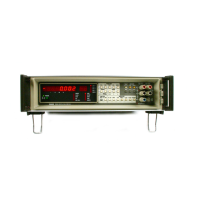8500
Series
Table
2A-1. Programming
instructions
(eorst)
Save Highest
and Lowest
Values
(Peaks
On) (cant)
For the 8500A, storage of
limit and peak values are
mutually exclusive. For the 8502A, limit
and peak
values
can be
held
in memory simultaneously.
NOTE
Limits are applied
after
all other
modifier
operations (Scaling,
Offset,
etc.) have been
performed.
CONTROL COMMAND CHARACTERS
The "B" characters activate binary or ASCII output format.
r N
B
V y
f
—
r
\
B
0
\ y
v J
f ^
(
B
1
V J
v
y
(
\
r
>
B 2
V y v
y
Single
Byte Binary Format
Single Byte ASCII Format
Binary 1S-B
16-Bit Parallel
used with Parailed ASCI! Interface
(Option
-07)
only.
The
front
panel
DMM
display is turned
on when the ASCII mode is entered and off when the binary mode is
entered.
The
Binary
Output Format
The
binary output format consists of five bytes.
The first four bytes comprise a 32-bit binary two’s complement
fixed
point number. An implied binary point for
this number is located between the first and second bytes. The
first
8-bit byte thus serves as the integer portion. The
24
bits of
the
next
3
bytes serve
as the binary fraction.
Additionally,
since this format cannot be used to hold the entire range of possible values
for the DMM, a fifth
byte is
used as an exponent. This exponent is a two’s complement binary number representing
the decimal
exponent of the binary
fixed point number defined
by
the first 4 bytes. An exception occurs in Limits
testing; the
response will then
be
single
byte binary two’s complement number.
16-Bit
Format
8-Bit
Format
Sign Bit
Byte 1 Byte 2 Byte 3 Byte 4 Byte 5
—
Byte 1 Byte 2
Byte 3 Byte
4 Byte 5
Exponent
Sign Bit
0000 0011
^
1000
000
0000 0000 0000 0000 0000 0001
I
—implied
binary point
=
3.5’
X
10’
=
35.0
2A-14

